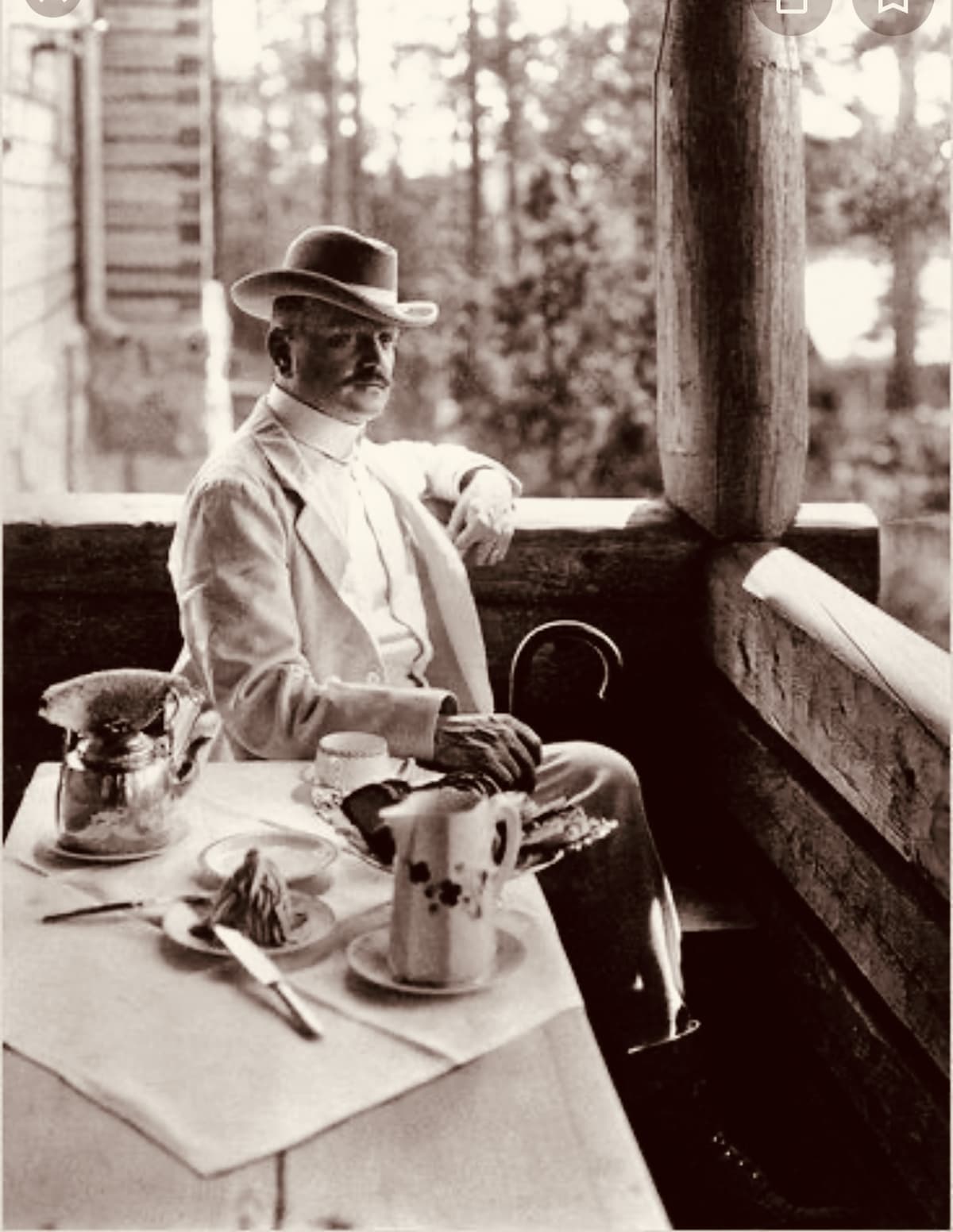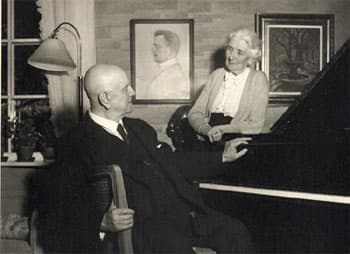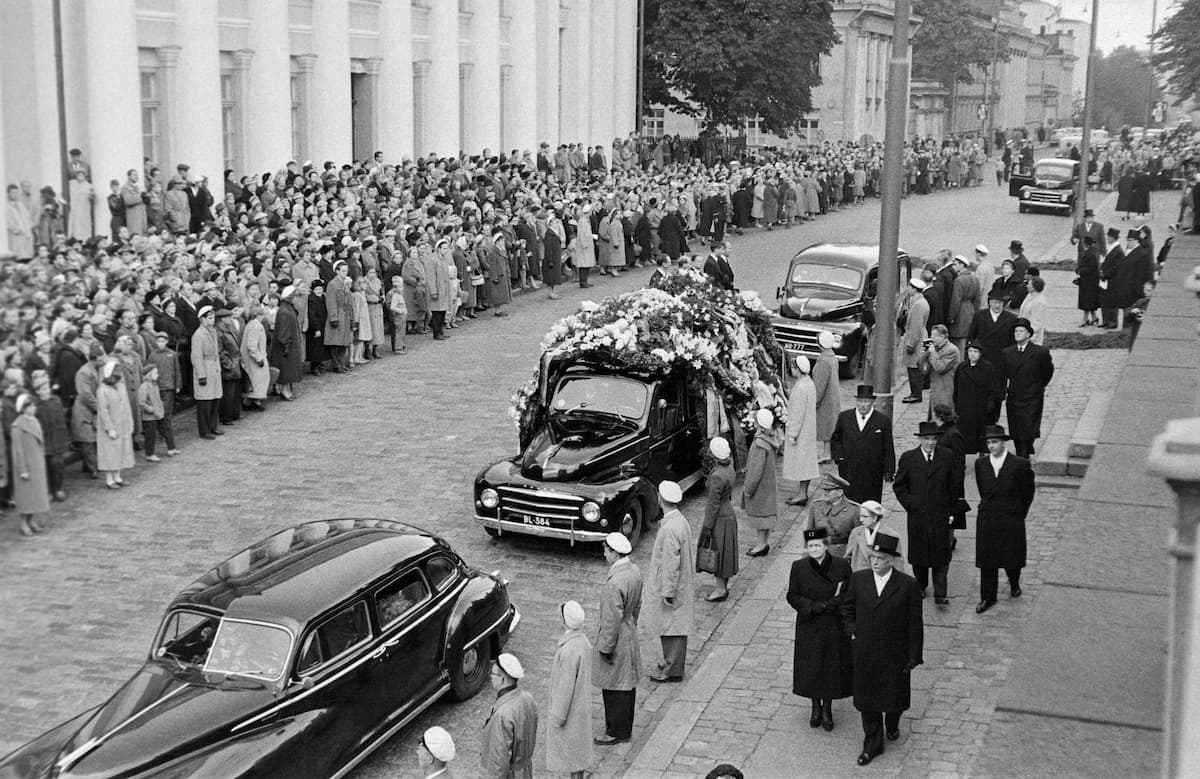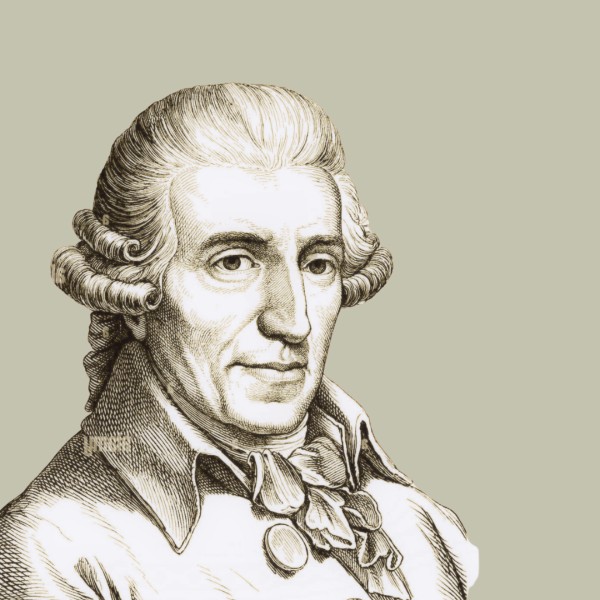Composer Jean Sibelius was born in 1865 in the city of Hämeenlinna, Finland. He went on to become the greatest composer that Finland ever produced.
Here are a few facts about his life and music:

Jean Sibelius having a tea
- Sibelius was famous for how he wove his Finnish identity into his music. During his lifetime, Finland was under Russian rule. Sibelius played a crucial role in fostering a sense of unique Finnish identity during that time and became a national hero.
- He was deeply inspired by folk stories and mythology. He was especially intrigued by stories found in the national epics of northern Europe.
- His works for orchestra – especially his tone poems and symphonies – are especially famous. They helped usher the symphonic form into the twentieth century, proving its relevance to a new generation.
- A noted perfectionist, he was famous for revising his works, sometimes substantially. Toward the end of his life, rather than leaving unfinished music behind, he chose to burn manuscripts of works he considered unworthy of preservation.
En saga (1891-92)
En saga (“A Saga”) can also be translated as “A Legend” or “A Fairy Tale.”
However, interestingly, we don’t know what actually happens in this fairy tale, because Sibelius left us no program. Whatever happens, though, it’s clearly dark, powerful, mysterious, and elemental.
Legend has it that the work began life as a student work for a chamber ensemble, not orchestra. If it did, that earlier work is now lost. But regardless of its origins, the Saga certainly exudes the energy and passion of young adulthood.
Kullervo (1891-92)
Kullervo is a seventy-minute, five-movement work for orchestra, male choir, soprano, and baritone. It is based on Finland’s national epic, the Kalevala.
The Kalevala traces the tumultuous life of a mythological hero named Kullervo. Over the course of the Kalevala, Kullervo is adopted by the people who killed his birth family, is sold into slavery, and even seduces a woman who turns out to be his biological sister.
As you can imagine, the music that portrays such an epic, upsetting story is both sprawling and staggering.
The massive scale of Kullervo appealed less and less to Sibelius as he matured, and he eventually repressed the work. Nevertheless, it’s a fascinating glimpse into the kind of composer that he might have evolved into…and it makes his smaller, tighter later work all the more intriguing.
Karelia Suite (1893)
In 1893, a student organization commissioned Sibelius to write some music for them. This music would benefit the education of residents of the Viipuri Province in Finland.
The word Karelia itself refers to a region of Finland between present-day Russia and Finland. The work takes inspiration from events in Karelia history, including a depiction of the Karelians rising up against their oppressors, the Lithuanians…quite the political statement to make in Russian-occupied Finland!
The Suite is charming and lyrical, and it was one of Sibelius’s first unalloyed triumphs. He arranged the music into a suite and published it.
Later, toward the end of his life, Sibelius burned the surviving sheet music that hadn’t been incorporated into the suite. Accordingly, the suite is all that remains of Karelia.
Finlandia (1899)
Finlandia is the work that Sibelius is most famous for. It was written for the Press Celebrations of 1899, which protested censorship by the Russian Empire.
In order to sidestep Russian censorship, the piece was often performed under an innocuous, sarcastic title like “Happy Feelings at the Awakening of Finnish Spring.”
However, the piece was a clear call to arms against oppression. It portrays struggle and then erupts into a serene hymn-like melody symbolizing the noble spirit of the Finnish people. It sounds like an old hymn, but it was actually composed by Sibelius especially for this work.
Symphony No. 2 (1901-1902)
At the time of the second symphony’s composition, Russia was cracking down on Finnish culture and even the use of the Finnish language.
It is unclear whether Sibelius wrote this symphony with explicit ideas of Finnish independence in mind, but its narrative of overcoming struggle resonated so deeply with Finnish audiences that it became known as the “Symphony of Independence.”
The symphony calls to mind the cold air of the Finnish climate and the warm hearts of the Finnish people. The finale is a passionate, bittersweet celebration: a vow to continue dreaming, no matter how difficult or impossible the fight.
Violin Concerto (1902-1903)
Sibelius was a violinist and viewed it as one of the great tragedies of his life that he was never able to become a virtuoso. Sibelius’ violin concerto was his bittersweet love letter to the instrument.
The first movement is icy and dramatic. The middle movement is a passionate romance. The finale is an eye-watering technical challenge that was once famously described as “a polonaise for polar bears.”

Aino and Jean Sibelius
This concerto is not only one of Sibelius’s most popular works; it is one of the most popular violin concertos ever written.
String Quartet, Voces Intimae (1909)
Sibelius’s only mature string quartet was this work, composed in 1909. Its title translated from Latin means “Intimate Voices.”
He once wrote a letter to his wife in which he cryptically described the String Quartet: “It turned out as something wonderful. The kind of thing that brings a smile to your lips at the hour of death. I will say no more.”
Symphony No. 5 (1914-15)
By 1915, Sibelius had become such a national hero that the Finnish government declared his fiftieth birthday a national holiday and commissioned a symphony from him. This would be his fifth.
He was deeply inspired. “It was as if God the Father was throwing pieces of mosaic from the edge of heaven and asking me to figure out what the pattern was,” he wrote of the composition process.
The fifth symphony is noble. It is also cleaner and more modern and direct than his overtly plush, romantic works of a decade earlier.
The third movement features a majestically swooping theme that famously brings to mind swan calls.
Symphony No. 7 (1922-24)
Sibelius’s final surviving symphony is his enigmatic seventh. (He wrote an eighth symphony, too, but was never satisfied enough to release it, and eventually burned it.)
The seventh symphony’s most unique trait is that it is one movement long. Most symphonies have four. Instead of building in breaks, Sibelius creates interest and contrast by switching up tempo and instrumentation.
The Tempest Suite I (1925-26)
Although he would live for three more decades after writing it, Sibelius’s music for The Tempest was one of his final completed works.
His depression and perfectionism, combined with the stress of world events in the 1930s and 1940s, as well as a rapidly modernizing musical world that he never felt fully comfortable in, all contributed to his lapse into silence.
The Tempest was composed for a big group of musicians, including a chorus, vocal soloists, and a huge orchestra. It was a bit of a full-circle moment, harkening back to the sprawling style of Kullervo.
New Yorker music critic Alex Ross called it “a shadow opera” and “perhaps the greatest Shakespeare opera never written.”
It was a fitting, if possibly early, ending to Sibelius’s creative life.
Conclusion

The funeral cortege of Sibelius
After he retired from writing music, Sibelius remained involved in the musical world and continued composing, just not sharing what he wrote. He eventually burned a great deal of his archive.
He lived with his beloved wife Aino at his cozy estate in the Finnish countryside, where he died a national hero in 1957. He is still celebrated today, not only in Finland, but all around the world.
For more of the best in classical music, sign up for our E-Newsletter

